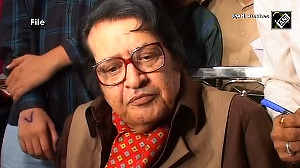Volatility in lending and deposit rates witnessed during the year is expected to end in 2009 with interest rates seen to be going down, due primarily to an easy monetary stance being pursued by the Reserve Bank of India to push growth.
Interest rates on home and auto loans, which touched a 10-year high in the beginning of 2008, continued to go up till the global meltdown manifested itself, prompting monetary authorities across the world to intervene and reverse the trend.
Making a case for further reduction in interest rates, the Mid-Year Review of the Economy, tabled by the Government in Parliament, said: "There is considerable scope for monetary policy easing over the next six to 12 months to offset the global increase in demand for money that is being transmitted to India."
ICICI Bank managing director K V Kamath also said "single digit lending rate and double-digit growth is what we should look forward to one year from now. Clearly, we see an environment of what we saw in 2001-02."
So what does this mean for a consumer? Home, auto and personal loans are expected to get cheaper next year while corporate borrowers too will also get credit at lower interest rates.
Interest rates peaked around August this year as the RBI tightened money supply to tame the spiralling inflation rate, which rose to 12.91 per cent for the week ended August 9.
The key short-term lending (repo) rate touched a high of 9 per cent while the borrowing (reverse repo) rate moved up to 6.5 per cent.
The global meltdown, triggered by the collapse of Lehman Brothers in September, caused liquidity to get dried up across the world, prompting regulators in different countries, including the RBI, to abandon their hawkish policy stance.
The liquidity crunch and fears of the global meltdown impacting the Indian economy adversely forced the RBI to pump in more funds into the system by relaxing the requirements of banks of keeping money with the central bank and parking a proportion of deposits in government securities.
Beginning October, the RBI reduced the cash reserve ratio, the amount that banks keep with the central bank, from 9 per cent to 5.5 per cent, and the statutory liquidity ratio from 25 per cent to 24 per cent.
In addition, the RBI took initiatives to boost credit supply to sectors like mutual funds, exports, textiles, the real estate and small and medium enterprises.
The RBI released about Rs 3,00,000 crore (Rs 3,000 billion) into the system, signalling a soft interest rate regime.
Taking a cue from the RBI, several public sector banks have cut lending rates since October, a measure it is hoped would increase the availability of credit for sectors feeling the impact of the slowdown.
Though banks have reduced interest rates, the credit flow to industry was tightened towards certain sectors like SMEs and infrastructure because of the fear of default. However, on the whole, credit disbursal growth was in the range of 25-30 per cent.
"Credit growth in 2008 has been robust, in the range of 25-29 per cent, on account of working capital requirements of small, mid and large-sized industries. Given current trends, credit growth for industry in 2009 is likely to be around 25 per cent," Bank of Baroda Chairman and Managing Director M D Mallya said.
Even the then finance minister P Chidambaram has emphasised that merely easing liquidity and reducing interest rates is not enough. The banks should shed risk aversion and provide credit to the productive sectors of the economy.
The government of late has been trying to impress upon public sector banks to provide credit to industry.
However, the central bank signal has not gone down well with private sector banks as they have largely refrained from reducing lending rates to a level signalled by the RBI's soft monetary stance.
Remaining non-committal on cuts in interest rates, ICICI Bank Joint Managing Director Chanda Kochhar said "in the (current) environment, I see interest rates softening and as that happens we will clearly pass on efficiency that we achieve to our customers. But when and by how much it's a little too early to predict".
However, its closest competitor HDFC Bank has slashed its prime lending rate by 50 basis points to 16 per cent earlier in December.






 © 2025
© 2025